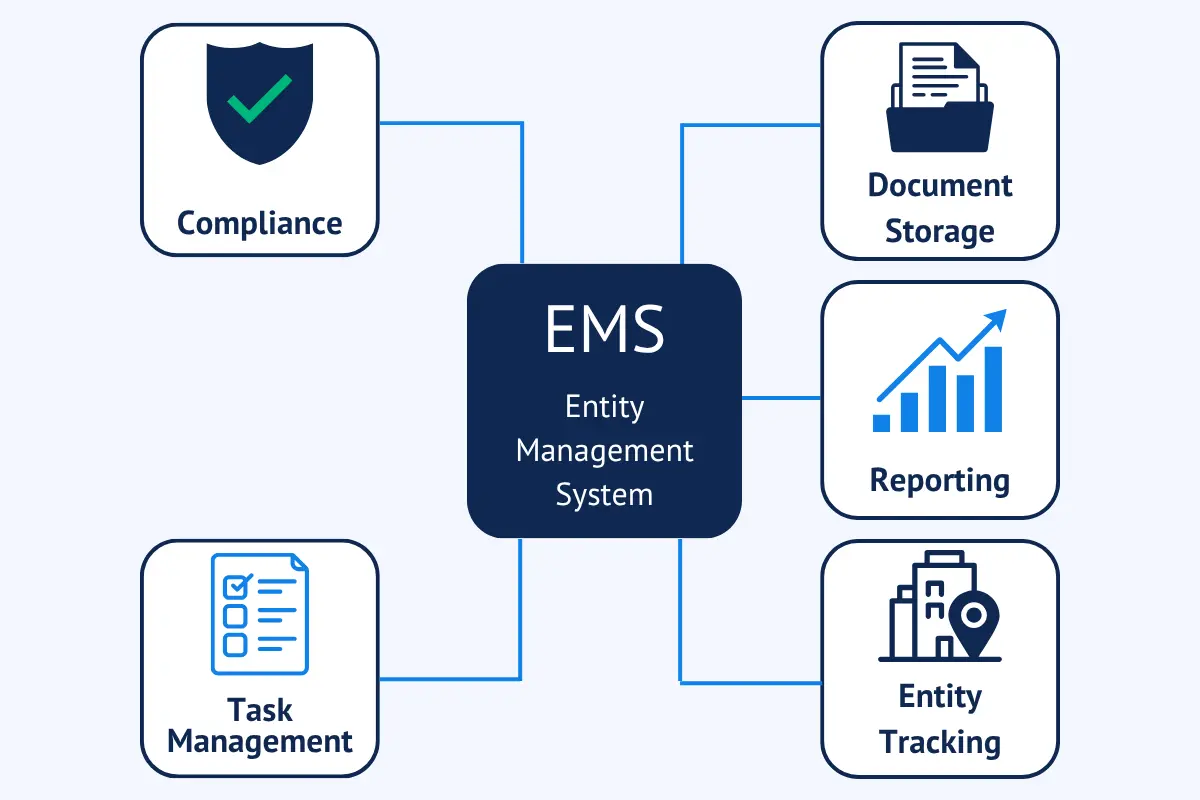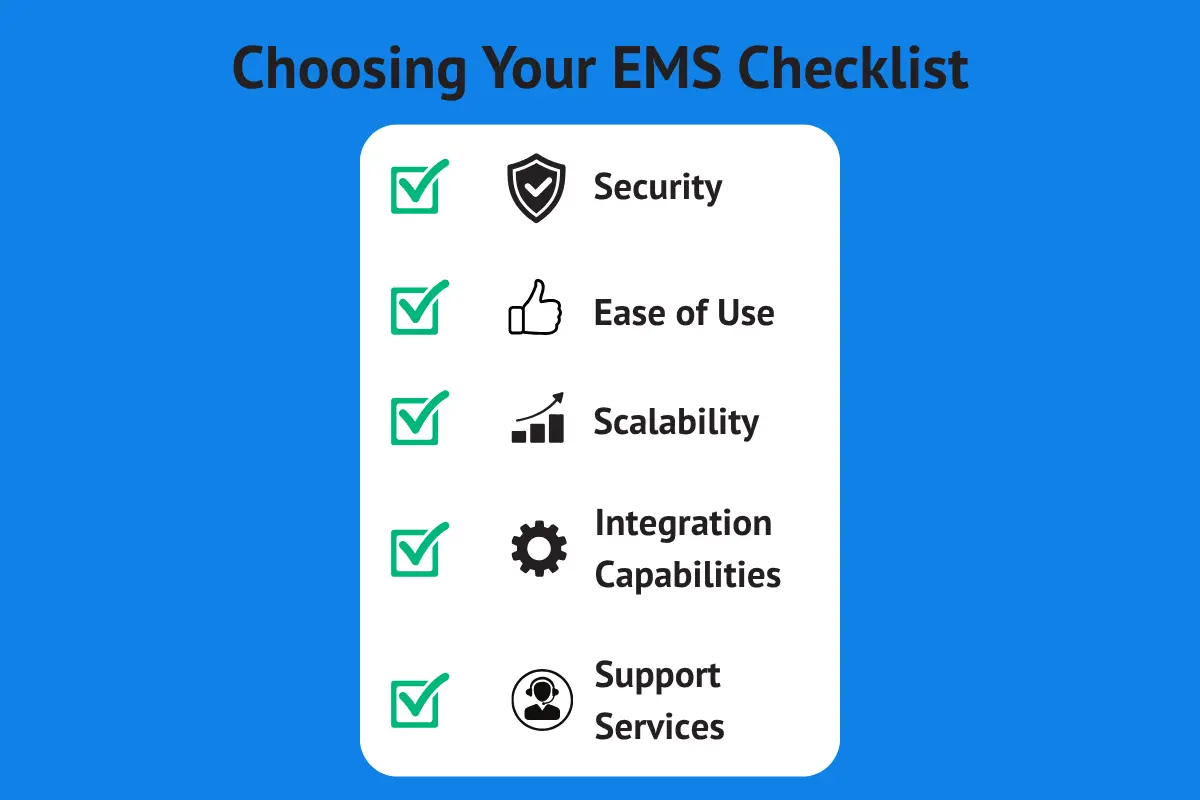Introduction to Entity Management Systems (EMS)

Managing multiple corporate entities exposes organizations to a complex web of compliance regulations and administrative challenges. One missed filing or overlooked requirement can trigger a cascade of associated costs, including penalties, legal fees, and reputational harm. Many organizations find themselves struggling to maintain accurate corporate records and keep up with evolving regulatory demands, especially as ownership structures become more complex and business operations span multiple jurisdictions.
As the business attorneys at Weber Law Group emphasize, “Proper record-keeping is vital for demonstrating compliance and the legal standing of your business.” Meeting compliance regulations is essential for avoiding penalties and maintaining good standing with regulatory authorities.
Entity management software offers a comprehensive solution to these challenges. By centralizing all critical corporate records, compliance documents, and governance data, EMS platforms provide organizations with real-time visibility and control over their legal obligations. These systems are designed to automate compliance tracking, streamline document management, and support the unique needs of businesses managing multiple corporate entities and ownership structures.
In this guide, we’ll introduce the fundamentals of Entity Management Systems and show how they can help your organization improve efficiency, reduce risk, and maintain control over all your corporate entities.
Key Takeaways
-
Entity management systems (EMS) centralize corporate records, automate compliance tracking, and streamline governance for organizations managing multiple entities
-
EMS platforms improve efficiency, reduce compliance risk, and provide real-time visibility into your corporate structure
-
Modern EMS solutions offer secure document management, customizable workflows, and robust audit trails—helping businesses stay compliant and make informed decisions.
-
Choosing the right EMS involves considering scalability, integration, user-friendliness, and ongoing support
-
With expert guidance and the right tools, businesses can transform entity management from a challenge into a strategic advantage.

Key Features of Entity Management Systems
Modern entity management systems offer comprehensive capabilities that transform how businesses handle corporate governance and compliance tracking. These features work together to eliminate manual processes and automate compliance tasks—such as filing deadlines and regulatory reporting—reducing human error and providing unprecedented visibility into your corporate data.
The most effective legal entity management software solutions seamlessly integrate these features, delivering intuitive workflows that support both day-to-day operations and strategic decision-making.
Centralized Data Management
Centralized data management provides a single source of truth for all corporate information, including corporate names, incorporation documents, board resolutions, and annual reports. Entity management software consolidates these records in one secure location, ensuring data accessibility for the entire organization. This centralized approach not only maintains data integrity but also streamlines collaboration and supports efficient audits or regulatory reviews.
Compliance Tracking and Reporting
Automated compliance tracking in entity management software monitors regulatory requirements across multiple jurisdictions, generating compliance calendars and sending notifications before critical deadlines. The system tracks annual filings, tax deadlines, and license renewals specific to each entity’s jurisdiction, helping organizations avoid late fees and maintain good standing. These features ensure your organization complies with all relevant regulations and deadlines, reducing administrative burden and minimizing risk.
For comprehensive compliance support, InCorp’s managed reporting services provide expert oversight to help your organization meet all regulatory requirements.
Document Management
Secure document management in entity management software includes version control, access permissions, and audit trails to ensure document integrity while facilitating collaboration across multiple departments. Users can quickly locate specific documents, track revisions, and manage approval workflows for sensitive materials, supporting both regulatory compliance and efficient operations.
Audit and Risk Management
Comprehensive audit trails and risk mitigation capabilities deliver the transparency required for modern corporate governance. By automatically logging all activities and changes, these systems ensure accurate, up-to-date records and enhance data integrity across departments. Detailed audit logs not only reduce organizational risk but also provide clear evidence to support compliance matters, regulatory reviews, and internal investigations, enabling smoother transactions and greater accountability.
According to Dr. Nick Oberheiden, Founding Attorney of Oberheiden P.C., "Corporations should ensure that all their transactions, as well as changes to corporate procedures, are documented in an audit trail that records the modifications made. If you are unable to accurately track your transactions in an audit trail, you may not pass your compliance audit because there will be a high indication of fraud or other forms of internal misconduct" (National Law Review).
Benefits of Using an Entity Management System
The transition from manual processes to entity management software delivers measurable improvements across multiple business dimensions. Research from NY Weekly demonstrates that businesses implementing entity management systems achieve a significant return on investment through reduced administrative costs and improved operational efficiency.
Efficiency and Time Savings
Manual entity management is time-consuming and prone to errors. By automating repetitive administrative tasks, entity management systems can reduce the time required for compliance activities by as much as 60–70%, according to industry case studies and reports. Tasks that previously required hours become streamlined, freeing staff for higher-value work.
Improved Compliance and Risk Reduction
Entity management software dramatically reduces compliance risk by providing automated monitoring and comprehensive documentation. Effectively managing entities is essential for maintaining compliance and reducing risk. As Diligent notes, "55% of organizations have no legal entity management policies in place, highlighting the challenges many organizations face in tracking extensive corporate records."
Better Decision-Making and Reporting
Real-time access to accurate entity data enables informed decisions. These platforms provide dashboards that give senior leadership comprehensive visibility into compliance status and operational metrics, supporting strategic decisions such as restructuring or expansion planning.
How EMS Helps with Corporate Governance
Corporate governance has evolved from a compliance checkbox to a strategic imperative affecting investor confidence and operational efficiency. Entity management systems provide the infrastructure needed to implement robust governance processes while maintaining flexibility for dynamic business environments. Organizations must walk a fine line between maintaining strict compliance and enabling operational agility to ensure both legal adherence and business responsiveness.
As the legal experts at Rendigs, Fry, Kiely & Dennis, LLP note, "Compliance is essential for all types of businesses. Regardless of a business's size, location and operations, effectively managing compliance is one of the keys to avoiding liability in both civil litigation and government enforcement proceedings."
An effective entity management system helps organizations navigate this fine line by automating compliance tasks and centralizing information, allowing for quick adaptations to regulatory changes and evolving business needs.
Streamlined Board and Shareholder Communication
Modern entity management platforms transform board communications by replacing manual, fragmented processes with streamlined digital workflows. These systems manage meeting schedules, distribute materials to board members, and maintain detailed meeting minutes in a centralized, secure location.
By consolidating these tasks, organizations enhance transparency, improve decision-making, and ensure that directors and shareholders always have timely access to critical information.
Governance and Compliance Controls
Entity management software provides tools to implement governance frameworks that adapt to changing regulations while ensuring compliance with reporting requirements across many entities. These platforms automate compliance tracking, send reminders for key deadlines, and generate comprehensive reports for regulators and stakeholders. By centralizing entity data and maintaining detailed audit trails, organizations can strengthen internal controls, promote accountability, and reduce the risk of non-compliance.
Ensuring Transparency and Accountability
Entity management platforms provide the visibility that key stakeholders—including executives, board members, and compliance teams—need to make informed decisions. By centralizing corporate data, these systems ensure that authorized users have real-time access to up-to-date information on entity structure and compliance status. This transparency supports effective oversight, strengthens internal controls, and promotes accountability throughout the organization.
Choosing the Right Entity Management System
Selecting the right entity management software requires a careful evaluation of your organization's current needs, operational complexity, and future growth trajectory. In addition to assessing features and scalability, organizations should also perform a customer support check—evaluating the quality and responsiveness of the vendor's support services. Taking these factors into account will help ensure your chosen solution meets both immediate requirements and long-term business goals.

Scalability and Flexibility
Your chosen entity management software should seamlessly handle an unlimited number of entities, users, and transactions without performance issues, even as your organization grows and expands into more jurisdictions. Look for platforms that offer customizable workflows to support a variety of legal structures and ownership structures.
Integration with Other Systems
Your entity management solution should integrate seamlessly with existing business systems—such as HR, finance, and compliance platforms—to avoid data silos and reduce manual data entry. Effective integration enables automated data sharing, maintains data accuracy, and streamlines workflows across your organization.
User-Friendliness and Support
Prioritize entity management systems with intuitive interfaces that make navigation and daily tasks straightforward for all users. Comprehensive customer support is equally important—the vendor's support capabilities become especially valuable during implementation and when regulatory requirements evolve.
Common Challenges and How to Overcome Them
Resistance to Change
Address staff resistance through clear communication about the benefits of the new entity management software, comprehensive training, and involving key users in the selection process. Demonstrate how the new system will save time, streamline workflows, and reduce compliance risk to help foster buy-in across the organization.
Data Migration and Integration Issues
Moving corporate data from legacy systems requires careful planning and collaboration with your provider. Develop a phased migration approach that includes thorough data assessment, incremental transfers, and robust testing to ensure data protection and system integrity throughout the process. Validate all migrated data to confirm accuracy and minimize disruption to business operations.
Ongoing Maintenance and Support
Entity management practices require ongoing maintenance, regular software updates, and continuous user support. Factor these requirements into your planning and budget allocation, and establish clear protocols for system maintenance, compliance updates, and user assistance to ensure long-term reliability and regulatory adherence.
Future Trends in Entity Management Systems
The entity management landscape continues to evolve as new technologies drive greater efficiency and security. Automation is streamlining routine tasks, artificial intelligence is beginning to automate complex compliance analysis, and blockchain technology offers enhanced document authenticity and transparency.
To stay ahead, businesses should monitor these emerging trends, invest in scalable and adaptable EMS solutions, and ensure their teams are prepared to leverage new tools as they become available.
Get Started with Entity Management Systems Today!
Entity management systems represent a fundamental shift from reactive compliance management to proactive corporate governance. As your business scales, maintaining a professional appearance and credibility becomes increasingly important. These platforms provide the infrastructure needed to uphold professional standards and manage complexity across multiple companies.
Ready to take the next step? Here's how to get started with an entity management system:
-
Assess Your Current Processes: Identify pain points in your existing entity and compliance management workflows
-
Define Your Requirements: List the features and integrations you need—consider scalability, user-friendliness, and support for multiple jurisdictions and legal structures
-
Research Solutions: Explore leading EMS platforms, read reviews, and request demos to compare their capabilities
-
Engage Key Stakeholders: Involve legal, finance, and compliance teams early to ensure buy-in and a smooth implementation
-
Plan for Data Migration: Develop a strategy to securely transfer corporate records from legacy systems
-
Establish Protocols: Set clear guidelines for ongoing maintenance, compliance updates, and user support
-
Invest in Training: Ensure your team is well-trained to maximize adoption and efficiency
-
Monitor and Optimize: Regularly review system performance and update processes as your business evolves
By following these steps, your organization can unlock the full benefits of entity management systems—improving efficiency, ensuring compliance, and enabling better decision-making as you grow.
FAQs
How does an EMS differ from traditional document management systems?
While traditional document management systems (DMS) focus primarily on storing, organizing, and tracking documents—essentially acting as digital filing cabinets—entity management software (EMS) is purpose-built for managing the full lifecycle of legal entities and corporate structures. EMS platforms go beyond basic document storage by offering specialized features such as compliance tracking, governance oversight, automated reminders for regulatory deadlines, and detailed audit trails. These capabilities enable organizations to maintain a single source of truth for entity data, streamline complex compliance requirements, and support proactive corporate governance functions that traditional document management systems are not designed to handle.
Can an EMS be customized for different industries?
Yes, many providers offer customizable solutions tailored to specific industries. Entity management systems can be adapted to meet unique regulatory requirements and business needs, whether that means supporting healthcare compliance, financial reporting standards, or global corporate structures. Custom workflows, reporting tools, and integrations ensure that organizations in any sector can configure the platform to fit their operational and compliance demands.
How secure is the data stored in an Entity Management System?
Data protection is a core feature of entity management systems. These platforms utilize advanced security measures such as encryption (both at rest and in transit), multi-factor authentication, and role-based access controls to ensure sensitive corporate records remain protected from unauthorized access. Regular security audits, secure data centers, and detailed audit trails further strengthen protection, while access is limited to authorized personnel only. These combined safeguards help organizations maintain data integrity, confidentiality, and compliance with evolving regulations.
Is training required to use an Entity Management System?
Yes, training is recommended to ensure staff can use the system efficiently and take full advantage of its features. Most providers offer onboarding resources such as tutorials, user guides, and live support to help employees become familiar with the platform. Investing in training helps teams manage entities more effectively, reduces errors, and maximizes the value of your EMS.
Simplify Entity Management with InCorp's Expert Support
Ready to transform your entity management from overwhelming to effortless? InCorp is your trusted partner for clarity and control over entity compliance and governance. Our team of experts provides the guidance, support, and cutting-edge tools your business needs to navigate corporate governance with confidence and precision.
With InCorp, you can streamline operations, reduce compliance risks, and gain real-time visibility into your entire corporate structure. Our entity management system app makes this even easier—giving you secure, on-the-go access to your entity data, compliance events, and important documents right from your mobile device. You can set reminders, track tasks, manage invoices, and receive real-time notifications, all with robust security features and customizable user access.
Take the first step toward simplified, stress-free entity management—contact InCorp today and see how our comprehensive business services can help your business thrive!
Share This Article:
Stay in the know!
Join our newsletter for special offers.